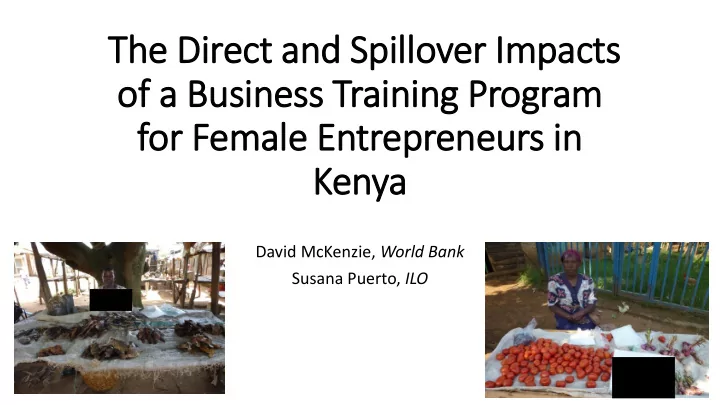

The Dir irect and Spillover Im Impacts of a Business Training Program for Female Entrepreneurs in in Kenya David McKenzie, World Bank Susana Puerto, ILO
Gender and Enterprise Together (GET ahead) business training program • highlights essential entrepreneurial skills from a gender perspective • training methodology is participatory, with practical exercises to teach concepts. E.g. women learn about the different types of costs involved in production, and how to account for their own costs through making lemonade; make necklaces to discuss a production process and the importance of different factors in product design. • Course is 5-days • Cost approx. US$222-333/women trained, offered for free
Sample • Listing of all market centers that were medium or large size in 4 largely rural counties • June 2013-November 2013 • 6,296 female-owned businesses in 161 markets were listed • Eligibility filter: • Phone number; age <=55; not just phone cards or m-pesa; <=3 employees; profits of 0 to 4000 KSH per week; sales<=50,000 KSH in last week; at least one year of schooling • Then baseline survey: • End up with sample of 3,537 women located in 157 separate markets
What do these businesses do? • average woman in our sample is 36 years old, has 9 years of schooling, and has been running her firm for just over 6 years • most common business types are selling fruit and vegetables, selling household goods, dressmaking, selling grains and cereals, and operating a food kiosk or small restaurant • average firm earns 1100 KSH (US$13) per week in profits, on sales of 4500 KSH. • Two-thirds of the women are currently married
Initial state of business practices • Few firms advertise their products, but most are well aware of the prices and products offered by the competition, and ask customers for feedback. • They attempt to negotiate for better prices on inputs, but only one third have a record-keeping system that allows them to know how much stock is on hand. • Only 32.7 percent keep business records, and only 21.6 percent use records to know which products are experiencing sales increases or decreases. • Few firms engage in financial planning.
Two-stage randomization 3,537 women in 157 markets 93 Treatment Markets 64 Control Markets 2160 Women 1377 Women
Two-stage randomization 3,537 women in 157 markets 93 Treatment Markets 64 Control Markets 2160 Women 1377 Women Don’t Invite to Invite to Training Training 1172 women 988 women
Standard approach: compare Treatment and Control within Markets Weekly Profit 2000 1800 14% 1600 increase 1400 1200 1000 800 600 400 200 0 Control Treatment
Two-stage approach Weekly Profit 1600 7.6% increase relative to 1550 pure controls 1500 4.4% decrease relative to pure controls 1450 1400 1350 1300 Spillover Control Pure Control Treatment
Average Profit of Firms in Market 1800 1600 1400 1200 1000 800 600 400 200 0 Control Markets Treatment Markets
Other results • Appears to be positive, but quite small, impact on business performance over first year: 0.05 s.d. or 7 percent increase • 2 percentage points more likely to gain a new customer during the last 3 months, and 4 percentage points less likely to lose one • Some evidence for negative spillovers, but depends on measure used • No change in empowerment (measured by 10 measures like being compelled to spend money on their husband or family, do they need someone’s permission to travel to sell a business asset, do they have money they have sole control over, etc) ; nor in entrepreneurial self-efficacy; nor in GET Ahead attitudes ( willingness to take risks to get ahead in business, planning for the future, feeling confident that one can find solutions to problems that arise, and keeping your eyes open for ways to improve the business) • Small increase in current and future subjective well-being (0.18 s.d.) • No change in access to finance • Heterogeneous impacts suggest, if anything, impacts stronger for those with better business practices to begin with, but not a precise effect.
What is going on? • Does the training lead to changes in business knowledge and business practices? • Business knowledge: • description of a business and then asking them seven questions that involve calculating the revenue, value of stock on hand, variable costs, total expenses, profits, fixed costs, and break- even point • Only get 2/7 right on average, and training doesn’t change this. • Business practices: • 26 questions that measure the marketing, record-keeping, buying and stock control, and financial planning of the firm. • Training has significant increase in use of these. • But impact not large: 0.05 increase in proportion of practices used, or about 1.3 more practices out of 26. • Consistent with results from other 5-day training programs (see McKenzie and Woodruff, 2015).
Next steps • 5- day course somewhat expensive, but doesn’t lead to enough of a change in business practices • Next step is to try more intensive and individualized assistance to business owners • Mentoring intervention underway
Recommend
More recommend